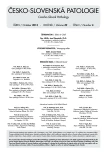Gunshot wounds caused by non-lethal ammunition on the porcine model post-mortem
Authors:
Peter Jabrocký 1; Juraj Pivko 2; Mária Vondráková 3; Boris Ťažký 4
Authors place of work:
OPS a KI KEÚ PZ Slovenská Ľupča
1; Centrum výskumu živočíšnej výroby Nitra, Lužianky
2; Katedra zoológie a antropológie, FPV, UKF v Nitre
3; Súdnolekárske a patologickoanatomické pracovisko, ÚDZS Banská Bystrica
4
Published in the journal:
Soud Lék., 58, 2013, No. 4, p. 50-54
Category:
Původní práce
Summary
In this article we focus on the effects of so called non-lethal ammunition. We studied possible mechanism of firearm injury formation as a consequence of using firearm on the body, to present a more comprehensive material in wound ballistics. We pointed out possible actions of a projectile causes on human, respectively other animal organisms, as well as to a manner in which an injury is caused by rifles or shotguns using non-lethal ammunition with rubber projectiles. In the experiment, we have focused on macroscopic analysis of the tissue penetrated by a rubber projectile fired from a long firearm and pump-action shotgun while focusing on the anatomical-morphological analysis of entry wounds to determine the effectiveness respectively, the wounding potential of the projectile. The results of the experiment based on the macroscopic analysis of entry wounds, cavities and exit wounds, show that when a rubber projectile penetrates the body it causes loss of the tissue (i.e. the minus effect) and mechanical disruption of the tissue similar to lethal projectile. Based on the measures and ballistic computations we concluded that in specific cases, like for example in a close range hit, a penetration of vital organs can cause serious or even lethal injuries.
Keywords:
weapon – entry wound – cavity – exit wound – non-lethal weapon – wounding potential
Zdroje
1. Šafr M., Hejna P. Střelná poranění. Praha: Galén, 2010.
2. Kneubuehl B.P. Geschosse, Ballistik, Treffsicherheit, Wirkungsweise. Motorbuch Verlag Stuttgart, 1994.
3. Klein L., Ferko A. a kol. Principy válečné chirurgie, Praha: Grada Publishing, 2005.
4. Liška P. Střelba z pistole a revolveru, Praha: Magnet-Press, 1994 : 43.
5. Jurásek M. Ranové účinky strely na ľudský organizmus, APZ Bratislava, 2004.
6. Planka B. a kol. Kriminalistická balistika, Plzeň: Aleš Čenek, 2010, 660 s.
7. Liška P. Odborná sdelení KÚ VB FSVB, Posudzovanie ranivého účinku strelnej zbrane v trestnom konaní, Praha: MV, 1980 : 34-35.
Štítky
Patologie Soudní lékařství ToxikologieČlánek vyšel v časopise
Soudní lékařství

2013 Číslo 4
Nejčtenější v tomto čísle
- Strelné poranenia spôsobené neletálnym strelivom na modeli ošípanej post-mortem
- Ruptura aneurysmatu arteriae vertebralis - popis případu
- Smrt způsobená úrazovou píštělí mezi tracheou a truncus brachiocephalicus - popis případu
- Tupé poranění oblouku aorty u ženy cestující na předním sedadle automobilu
